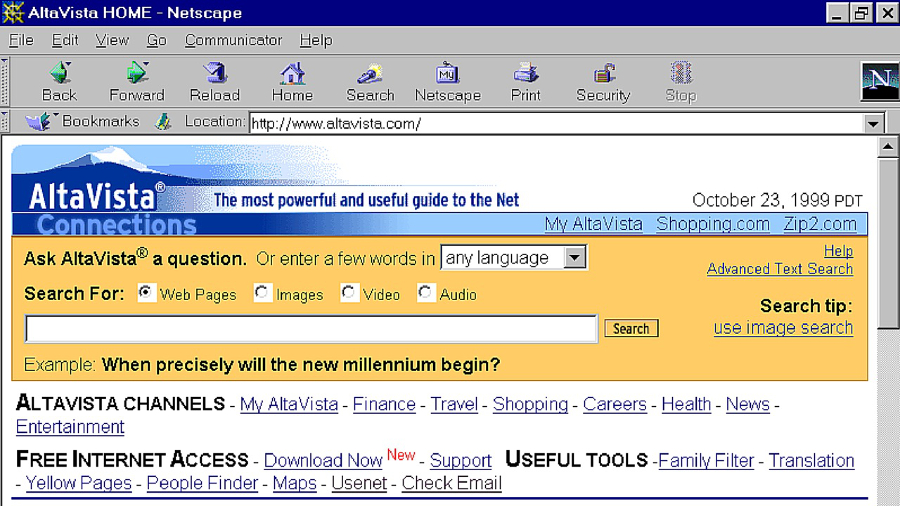Back to basics: is Web 1.0 making a comeback?
Has the internet simply got too clever for its own good?

Is your website optimised for Netscape 2.0? Fifteen years ago that was a critical question in IT, but it's those early days of the internet that some yearn for. Back in the 1990s, chat rooms weren't global platforms demanding participation, and hosted no advertising. Websites were ugly, but simplistic. Distractions were few. Would you go back?
Are modern websites too demanding for some users?
"The capability of modern browsers to display complex websites can lead to the overuse of interactions and updating data," says Scott Byrnes-Fraser, Head of UX design at Adaptive Lab and formerly both Amazon's manager of UX design and a BBC creative director. He adds that while many modern sites are demanding for some users, many old sites were, too. The key is to test a website's usability.
"The focus on user-centred design practices – user testing, user research, and usage data analysis – is leading to many websites becoming less demanding on users," says Byrnes-Fraser. "I would argue that this is a step forward to a more responsive and adaptable web, rather than a reversal to the static Web 1.0."

Web 1.0: the read-only internet
For some, Web 1.0 is a distant memory of a different internet, one that relied on dial-up. For the younger generation, Web 1.0 doesn't mean anything. Was there a time before broadband? For them, a liking of Web 1.0 designs and ideas is a retro, avant-garde movement, not a return.
Loosely defined as the internet in 1996 when it had a global user base of just 45 million people across the globe, Web 1.0 was all about simple, read-only home pages. This was a time before online shopping and social media; chat rooms, web forms, directories and rudimentary banner adverts were all the rage. There was no Google – the arbiters of Web 1.0 were the search engine AltaVista, and Netscape, the dominant browser.
The next decade changed everything, with Web 2.0 evolving to deliver a more interactive experience to an awful lot more people – around a billion people were using the internet by 2006. Blogging, tagging, community websites, Wikipedia and the birth of Google all followed, and slowly led to the portable, personalised web we have today.
It's better-looking, location-aware, responsive to what device it's being viewed on, built around apps, fully optimised for search, and riddled with advertising. It's a whole lot more demanding and intrusive for its current three billion users than Web 1.0 ever was. Despite the advances, for some it's Web 1.0 that represents when the internet was at its best.
Sign up to the TechRadar Pro newsletter to get all the top news, opinion, features and guidance your business needs to succeed!

Is there a yearning for Web 1.0?
"Yes," says Richard Healy, co-founder of BaseKit, a web development platform that works with the likes of names.co.uk and 123.reg. "Markdown files and static site creation is on its way back – they're quick to create and easy to deploy. I've seen a lot more sites being deployed as Github pages." Healy thinks that static file creation makes sense for small sites that do not change much, such as instructional sites. "We spend a lot of our time worrying about databases, speed and deployment," says Healy. "Sometimes it just makes sense to go back to basics."
Web developers are obviously at the forefront of the penchant for Web 1.0, and there's a definite shift in how websites are being developed. "Lots of developers are raving about Jekyll at the moment," says Healy. "It's a simple static website generator that's easy to deploy … I think there will be more sites generated on this technology."
Some argue that Web 1.0 is still with us. "The majority of web is still web 1.0," says Byrnes-Fraser. "Most small businesses still use very static sites, albeit responsive static sites."
- 1
- 2
Current page: Introduction and the yearning for Web 1.0
Next Page Ello, Rooms and the search for simplicityJamie is a freelance tech, travel and space journalist based in the UK. He’s been writing regularly for Techradar since it was launched in 2008 and also writes regularly for Forbes, The Telegraph, the South China Morning Post, Sky & Telescope and the Sky At Night magazine as well as other Future titles T3, Digital Camera World, All About Space and Space.com. He also edits two of his own websites, TravGear.com and WhenIsTheNextEclipse.com that reflect his obsession with travel gear and solar eclipse travel. He is the author of A Stargazing Program For Beginners (Springer, 2015),
